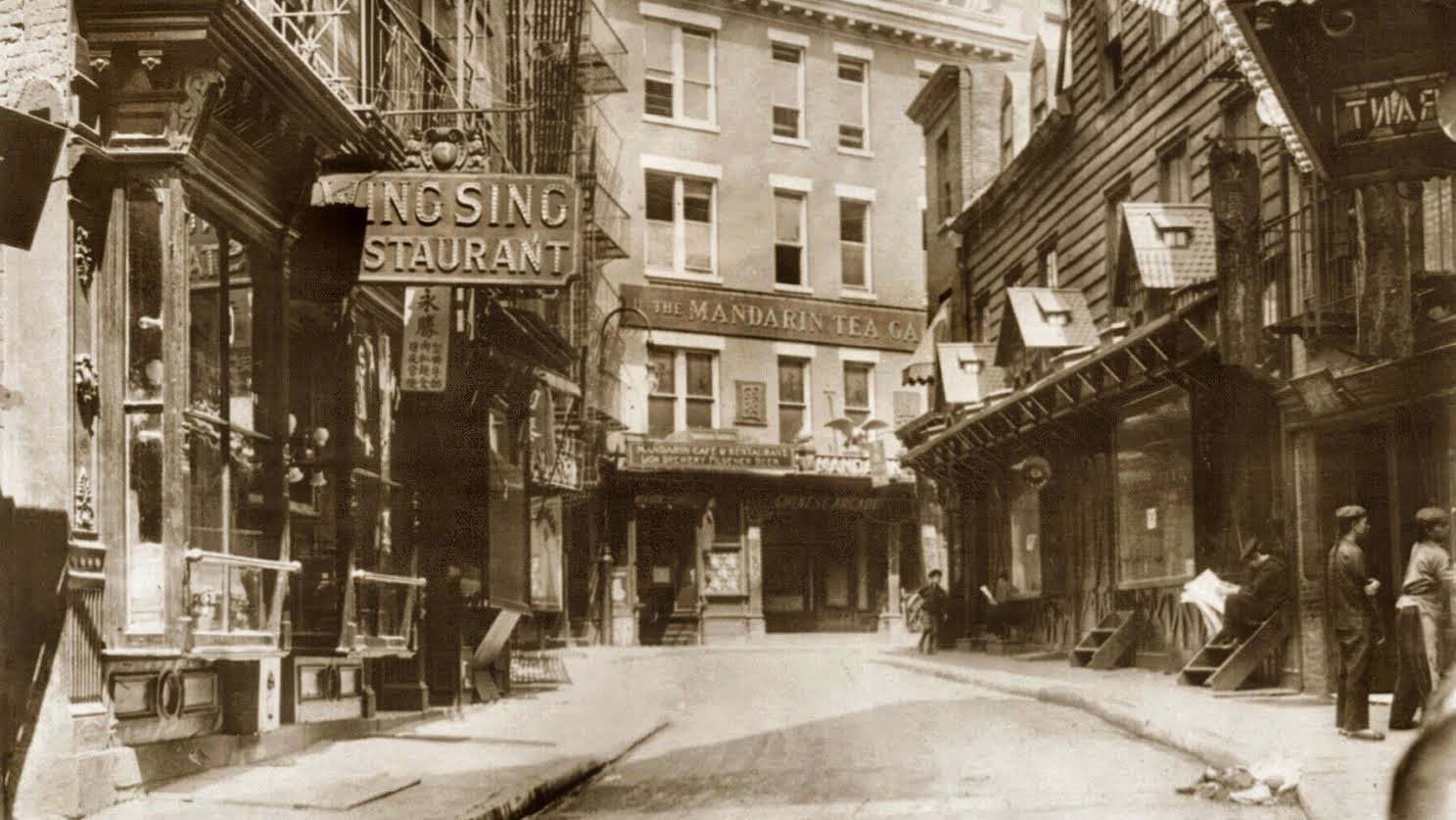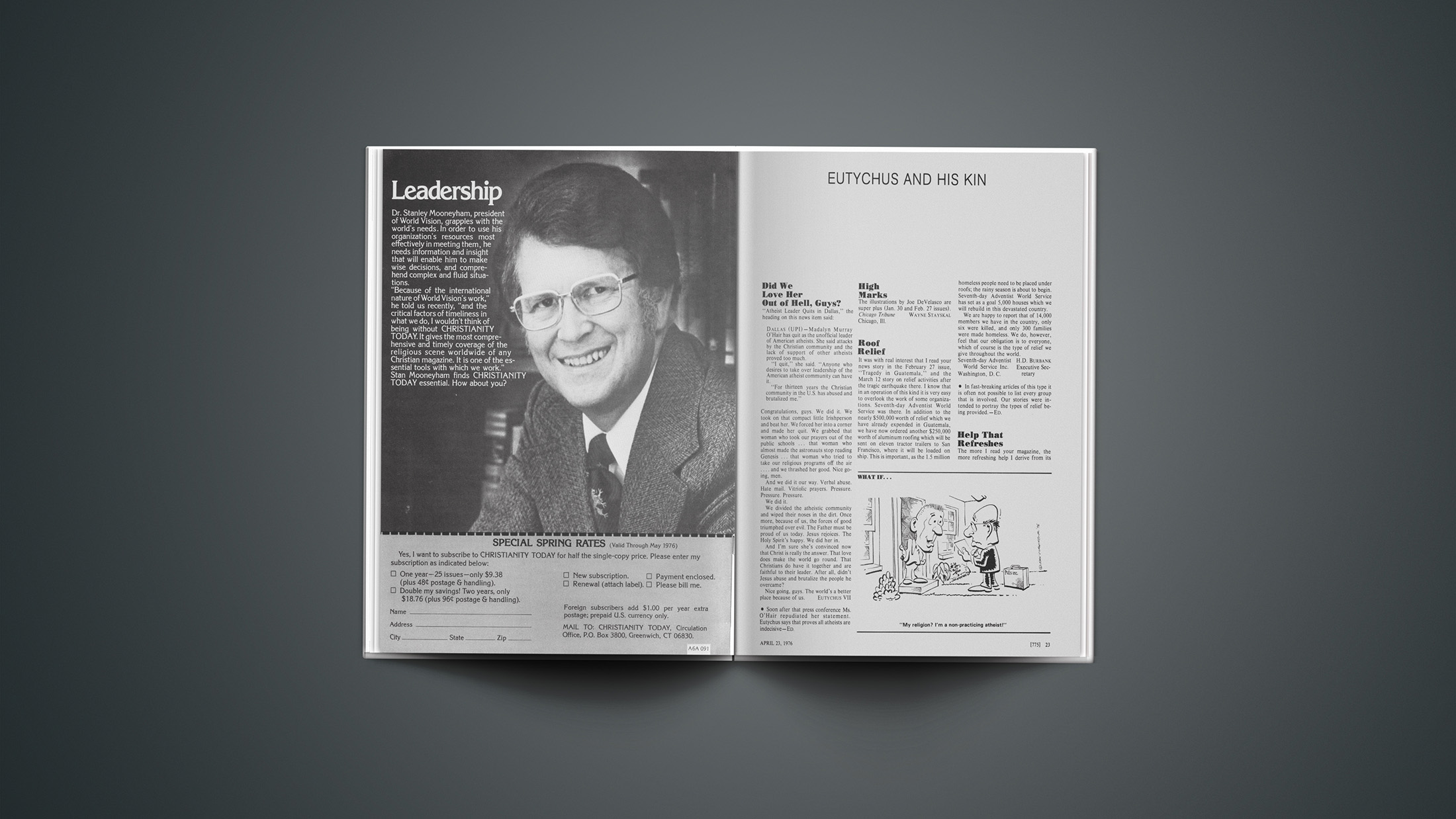Young, educated, and successful, Mabel Lee had a bright future ahead of her in 1924. She was the daughter of a prominent Chinese American pastor and community leader, she had recently finished a PhD, and her work to promote women’s suffrage had been covered by The New York Times. She was well-connected with the emerging leaders in China and was just beginning to establish her own place in shaping its future when tragedy struck. Her father, who had dedicated his life to ministering to the Chinese American community in New York, passed away suddenly, leaving his ministry and his family behind. Astonishingly, Mabel chose to give up her incredible opportunities in China to return and carry on the ministry her father started, a ministry that still endures today.
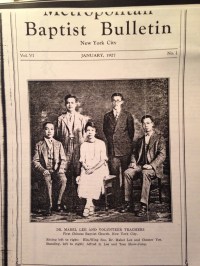
The early 20th century was an extraordinarily difficult period for Chinese Americans. Decades of federal legislation prohibiting Chinese working class immigrants from coming to America had taken its toll. Exclusion laws resulted in an overwhelmingly male Chinese population. Residential racial segregation created the urban ghettos that became America’s Chinatowns. In turn, these communities were riddled with tensions between rival fraternities, family associations, and political factions (known as tongs) that often engaged in human trafficking and violent crimes. Popular opinion considered Chinese people “heathen” and perpetual foreigners.
Protestant missionaries and Chinese converts were among the few that engaged Chinese immigrants, often driven by evangelistic and social reform motives. Many missionaries and converts also publicly refuted popular opinions of the Chinese, portraying them (especially the American-born) in reports, magazines, and even Congressional hearings as fully capable of becoming Americans. Despite their efforts, Christians made up a tiny percentage of the Chinese American population and missions’ efforts were solely dependent on the support of Protestant denominations.
Enter Mabel Lee and First Chinese Baptist Church, New York City. Under Mabel’s leadership as de facto pastor of the Chinatown-based church and social service organization, First Chinese Baptist Church became the first self-supporting Chinese church in America. A graduate of Colombia University with a PhD in economic history, the Chinese American community leader led the church for more than 40 years. It still exists today.
Christian, Suffragist, Scholar
Mabel was the only daughter of a pioneering pastor and missionary, the reverend Lee To (1868–1924). Born in Guangzhou, To came to the United States in 1880 as a contract laborer just two years before the Chinese Exclusion Act (CEA) banned labor immigration. To learned English at a missionary school, an asset that helped him gain standing as a merchant and consequently adjust his immigration status. (The CEA didn’t apply to merchants and clergy, who were allowed to travel between China and the US freely.)
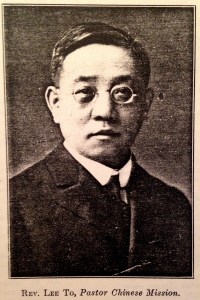 Did We Love Her Out Of Hell, Guys?“Atheist Leader Quits in Dallas,” the heading on this news item said:
Did We Love Her Out Of Hell, Guys?“Atheist Leader Quits in Dallas,” the heading on this news item said:DALLAS (UPI)—Madalyn Murray O’Hair has quit as the unofficial leader of American atheists. She said attacks by the Christian community and the lack of support of other atheists proved too much.
“I quit,” she said. “Anyone who desires to take over leadership of the American atheist community can have it.
“For thirteen years the Christian community in the U.S. has abused and brutalized me.”
Congratulations, guys. We did it. We took on that compact little Irishperson and beat her. We forced her into a corner and made her quit. We grabbed that woman who took our prayers out of the public schools … that woman who almost made the astronauts stop reading Genesis … that woman who tried to take our religious programs off the air … and we thrashed her good. Nice going, men.And we did it our way. Verbal abuse. Hate mail. Vitriolic prayers. Pressure. Pressure. Pressure.We did it.We divided the atheistic community and wiped their noses in the dirt. Once more, because of us, the forces of good triumphed over evil. The Father must be proud of us today. Jesus rejoices. The Holy Spirit’s happy. We did her in.And I’m sure she’s convinced now that Christ is really the answer. That love does make the world go round. That Christians do have it together and are faithful to their leader. After all, didn’t Jesus abuse and brutalize the people he overcame?Nice going, guys. The world’s a better place because of us.EUTYCHUS VII• Soon after that press conference Ms. O’Hair repudiated her statement. Eutychus says that proves all atheists are indecisive—ED.High MarksThe illustrations by Joe DeVelasco are super plus (Jan. 30 and Feb. 27 issues). Chicago TribuneWAYNE STAYSKALChicago, Ill.Roof ReliefIt was with real interest that I read your news story in the February 27 issue, “Tragedy in Guatemala,” and the March 12 story on relief activities after the tragic earthquake there. I know that in an operation of this kind it is very easy to overlook the work of some organizations. Seventh-day Adventist World Service was there. In addition to the nearly 0,000 worth of relief which we have already expended in Guatemala, we have now ordered another 0,000 worth of aluminum roofing which will be sent on eleven tractor trailers to San Francisco, where it will be loaded on ship. This is important, as the 1.5 million homeless people need to be placed under roofs; the rainy season is about to begin. Seventh-day Adventist World Service has set as a goal 5,000 houses which we will rebuild in this devastated country.We are happy to report that of 14,000 members we have in the country, only six were killed, and only 300 families were made homeless. We do, however, feel that our obligation is to everyone, which of course is the type of relief we give throughout the world.H.D. BURBANKExecutive SecretarySeventh-day Adventist World Service Inc.Washington, D. C.• In fast-breaking articles of this type it is often not possible to list every group that is involved. Our stories were intended to portray the types of relief being provided.—ED.Help That RefreshesThe more I read your magazine, the more refreshing help I derive from its articles. I am especially grateful for the article “Christianity Faces the Eighties” (Feb. 27). As much as we’d like to stick our haloed heads in the sands and wait till all the bad weather passes, it just isn’t practical.… The article on euthanasia in the same issue is one of which I hope to see many more.(Mrs.) CHARLOTTE RIEGELLumphanan, AberdeenshireScotlandThank you for publishing Gary Hardaway’s [article]. We Christian futurists rejoice at the appearance of such articles in your journal. Perhaps instead of developing a “last days” mentality, we should develop a “first days” mentality. From this perspective we can define a more forceful and creative ethic for the 1980s. Hardaway’s article would have been much stronger had he expanded the thoughts in the last eight lines of his second point. This is the heart of the matter.R. HOWARD MCCUEN, JR.Stone United Presbyterian ChurchWheeling, W. Va.The Rent Free MythIn your editorial “Where Do Retired Pastors Live?” (March 12) you made an excellent point, but at the expense of disseminating some false information. You referred to the “pastor’s rent-free housing,” and this just isn’t so. Instead of a minister earning X number of dollars he earns X minus ,000 (give or take 0) and he lives in the parsonage. He is, in effect, renting from the church. His situation differs from other renters because most churches do not adequately maintain their parsonages. The minister keeps it up; he improves their property while its value appreciates with the rising cost of real estate. Having renovated three parsonages with my own time and money, and having spent the first nineteen years of my ministry without a nickel of equity built up, I appreciate the sentiment of your article, but wish to demythologize the ancient superstition that the minister lives rent-free.W. NORMAN MACFARLANEPhilippus United Church of ChristCincinnati, OhioMarred InterviewYour welcome and timely interview with Charles Colson (March 12) was sadly marred by the egregious picture on the cover.… I know he became famous for saying that he’d walk over his grandmother if it would help Nixon get reelected, but that unfortunate statement belongs to his pre-conversion past which he has repudiated. Why rake it up again when he is trying hard to make a new life for himself?EDWARD A. JOHNSONOhiowa, Neb.Unique ThumbnailSincere, hearty thanks are due to you once again for providing a splendid thumbnail review of the latest Christian books (March 12). No one else does this sort of thing.ALAN J. RIDERHoly Cross Lutheran ChurchLivermore, Calif.Where ‘Obey’?My friend Harold Lindsell seems to have read something into the New Testament when he refers to the biblical injunction for wives to “obey” their husbands (Current Religious Thought, “Egalitarianism and Scriptural Infallibility,” March 26). Nowhere in the New Testament are wives commanded to “obey” their husbands or husbands encouraged to exercise authority over their wives. However, the New Testament requires all Christians to be subject to each other. This includes wives submitting to their husbands as well as husbands to their wives.GILBERT BILEZIKIANAssociate Professor of Biblical StudiesWheaton CollegeWheaton, IllHarold Lindsell’s article has prompted this support of egalitarian marriage and biblical infallibility. The two are not incompatible as he has implied. The crux of his argument seems to be that egalitarian marriage and wifely submission are mutually exclusive concepts, and since wifely submission has biblical support that therefore egalitarian marriage cannot. They need not be mutually exclusive concepts as long as wifely submission is not considered the whole picture. A marriage of mutual submission of wife to husband and husband to wife certainly qualifies as an egalitarian marriage. Moreover, it does not contradict Scripture. Since mutual submission is the pattern set up for all Christians, then surely this pattern must exist in the Christian marriage as well. Nowhere in the Bible is the husband commanded to “lord it over” his wife. That kind of language is reserved for the curse of sin as a result of the Fall. Egalitarian marriage is the pattern present in Genesis before the Fall, and there is no indication that the “new heaven and the new earth” will have anything to do with the order established by that curse. In the meantime, husbands are told by Paul to love their wives. Our understanding of what it means to love as we have learned through the whole messsage of the New Testament is intimately bound up in the idea of service and submission. If Paul’s language on the subject (submission for wives and love from husbands) in the Ephesians 5 passage seems to indicate different requirements for the different sexes it is only because we … are blinded by the order that sin has created—and have even gone so far as to absolutize that order and claim that God’s infallible Word promotes it.BETTY M. VANDERSCHAAFIowa City, IowaI would like to ask Dr. Lindsell how he interprets the following passages in terms of twentieth-century church practice: First Corinthians 11:2–16 (veiling of women, length of hair); First Corinthians 14:33–35 (women speaking in church); First Timothy 2:8–15 (women’s apparel, women not allowed to teach or have authority over men).… If he is going to call Drs. Jewett and Mollenkott, Ms. Hardesty and Ms. Scanzoni heretics, then let him come right out and say so. These are very serious accusations [he] is raising.JOHN D. KEPLERAssociate PastorNewport Covenant ChurchBellevue, Wash.To Think And ActLet me thank you for the outstanding issue of January 16. As I turned through the pages before reading, I found it hard to know where to begin.… “The Passivity of American Christians” is one of the finest pieces I have seen in a very long time. Indeed it does give us much to think upon and some things to act upon, which is always helpful. Just one little question about what I feel sure was an error: surely in the twelfth line down on the last column the word protest should have been protect! This would make a difference in the meaning, and it might not be as readily recognizable as wisdom in the final paragraph, which any reader would know should be wisdom.CLARA H. STUARTNew Orleans, La.• Thanks for the corrections—ED.ERRATUMIn the February 27 news story “The Rise and Fall of Billy James,” it was stated that the board of American Christian College agreed to give Mr. Hargis an annual stipend of ,000. Instead, the funds were to come from the David Livingstone Missionary Foundation
Learning English wasn’t the only significant life change To experienced after he arrived in America. In 1890, To became a Christian at a Chinese mission in San Francisco. Three years later, he gave up his business and enrolled in a Baptist seminary in Guangzhou. After To completed his theological training in New York City, the American Baptist Home Mission Society appointed him first to be a missionary to the Chinese in Washington State in 1898 and then as a minister at the Morningstar Mission in New York City’s Chinatown in 1904. To thrived in his work in Chinatown and gradually became a member of the community’s elite. In 1921, he became the president of the Chinese Consolidated Benevolent Society, the leading Chinese American coalition of powerful Chinese family associations. Because he discouraged traditional Chinese religious practices and modernized and Americanized Chinatown, American Baptists hailed him as the “Christian mayor” of Chinatown.
To’s daughter, Mabel, was born in Guangzhou in 1896. She spent her early childhood in China and enrolled in a missionary school where she became proficient in English. She reunited with her parents shortly after her father was appointed to the Morningstar Mission and attended New York City’s public schools until she was accepted to Barnard College. Mabel then earned a PhD in economic history at Columbia University in 1921.
Mabel proved to be a gifted communicator and an ambitious young leader who was dedicated to improving society, especially for women and for China. Like suffragist Charlotte Perkins Gilman, she argued that modern democracy could not survive without woman’s suffrage. In the May 1914 issue of The Chinese Student Monthly, Mabel argued that woman’s suffrage or the early feminist movement was “nothing more than the extension of democracy or social justice and equality of opportunities to women.” Mabel’s prominence grew; in 1915, her speech at a suffrage workshop was covered by The New York Times.
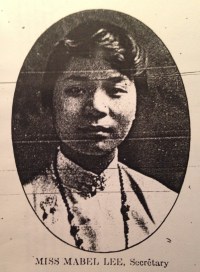 Have you ever watched a child stand gazing at a box of chocolates, a frown of concentration wrinkling that space between the eyebrows? “Only one, Jessica. Take any one you want, but you may have only one. Choose.” Shall it be the biggest one, or might that small round one be the favorite peppermint cream? Then again the long one could contain nougat, and with tiny bites that would last longer. The agony of choice.Have you pored over pictures and maps, imagined weather conditions, and thought about the alternatives for your precious “only one” vacation? Shall it be mountains or seaside? Will you choose fresh air and exercise or travel and sightseeing? The agony of choice.Then there are the crisis decisions—choosing between two job offers, saying yes or no to a marriage proposal, choosing to live in the country or in the city. Hours, days, weeks, months, years, or a lifetime can be affected by a single choice. This is one of the earliest lessons a child needs to learn: if you choose to go swimming, then you can’t go to the circus; if you choose to go to the playground, then you won’t be here when daddy gets home; if you choose to take that puppy home, then you’ll have to take care of it.What the Word of God conveys about the far-reaching results of choice should have been ingrained in people from the teaching of Adam and Eve to their children on down through the grandchildren and subsequent generations. That it was not is clear from history. Isaiah speaks God’s warning to people in chapter 31:
Have you ever watched a child stand gazing at a box of chocolates, a frown of concentration wrinkling that space between the eyebrows? “Only one, Jessica. Take any one you want, but you may have only one. Choose.” Shall it be the biggest one, or might that small round one be the favorite peppermint cream? Then again the long one could contain nougat, and with tiny bites that would last longer. The agony of choice.Have you pored over pictures and maps, imagined weather conditions, and thought about the alternatives for your precious “only one” vacation? Shall it be mountains or seaside? Will you choose fresh air and exercise or travel and sightseeing? The agony of choice.Then there are the crisis decisions—choosing between two job offers, saying yes or no to a marriage proposal, choosing to live in the country or in the city. Hours, days, weeks, months, years, or a lifetime can be affected by a single choice. This is one of the earliest lessons a child needs to learn: if you choose to go swimming, then you can’t go to the circus; if you choose to go to the playground, then you won’t be here when daddy gets home; if you choose to take that puppy home, then you’ll have to take care of it.What the Word of God conveys about the far-reaching results of choice should have been ingrained in people from the teaching of Adam and Eve to their children on down through the grandchildren and subsequent generations. That it was not is clear from history. Isaiah speaks God’s warning to people in chapter 31:Woe unto them that go down to Egypt for help; and stay on horses, and trust in chariots, because they are many: and in horsemen because they are very strong: but they look not unto the Holy One of Israel, neither seek the LORD!… Now the Egyptians are men, and not God: and their horses flesh, and not spirit. When the LORD shall stretch out his hand, both he that helpeth shall fall, and he that is helpen shall fall down, and they shall all fall down together [vv. 1, 3].
Here is a promise of God: those who choose to seek help by turning away from him will fall down in a heap along with the people they have turned to. A twisted heap of arms and legs, fallen horses and men, is the picture we are given. Turn the page back to chapter 30, verses 1–3:
Woe to the rebellious children, saith the LORD, that take counsel, but not of me; and that cover with a covering, but not of my spirit, that they may add sin to sin: that walk to go down into Egypt, and have not asked at my mouth; to strengthen themselves in the strength of Pharaoh, and to trust in the shadow of Egypt! Therefore shall the strength of Pharaoh be your shame, and the trust in the shadow of Egypt your confusion.
If a jumble of human beings and horses all in a heap is too far removed from our experiences, “confusion” is not—confusion of ideas, emotions, solutions, identity, purpose, ambitions, motives. The very solutions themselves that are being given by the twentieth-century “counsel”—the solutions, for example, of abortion, of denying the framework given for the home, of putting self-fulfillment first, of seeking happiness in divorce for unbiblical reasons and a new marriage—will end in shame and confusion.Joshua makes it very clear in chapter 24, verses 14–20, that it is not possible to serve God and false gods at the same time: “Choose you this day whom ye will serve … but as for me and my house, we will serve the Lord” (v. 15). The Creator of the orderly universe is the Author of a plan for each of our lives that “fits” psychologically, emotionally, materially, physically, spiritually. To seek true solutions from the author of chaos—that is, Satan and all his false prophets and philosophies—is to bring on a set of results that will be chaos.“And Elijah came unto all the people, and said, How long halt ye between two opinions? if the LORD be God, follow him: but if Baal, then follow him. And the people answered him not a word” (1 Kings 18:21).Oh, you say, I do choose the living God; I did long ago. My cry comes with David’s in Psalm 18:31, “For who is God save the Lord? or who is a rock save our God?” I made a big choice, and now I am a child of this Creator God, the God of perfect wisdom and order.But it is still true for each of us that there is moment-by-moment choice affecting our lives, bringing results in us and because of us in other people. We bring on a chaos of confused ideas and misunderstandings if our choices are not moment by moment to serve this Lord whom we have chosen as Saviour. Review Isaiah 50:7, 10, 11 once again:
For the Lord GOD will help me; therefore shall I not be confounded: therefore have I set my face like a flint, and I know that I shall not be ashamed.… Who is among you that feareth the LORD, that obeyeth the voice of his servant, that walketh in darkness, and hath no light? let him trust in the name of the LORD, and stay upon his God. Behold, all ye that kindle a fire, that compass yourselves about with sparks: walk in the light of your fire, and in the sparks that ye have kindled. This shall ye have of my hand; ye shall lie down in sorrow.
When we do not know where to turn and someone offers us a solution that is contrary to the written Word of God, do we wait and cling to the Word, asking God to direct us? Setting the face “like a flint” is not done in a moment when everything is clear and easy in the path ahead. When one declares, “I will not be confounded,” it is at a time when one faces danger. To “walk in the light of your [own] fire, and in the sparks that ye have kindled” is similar to going to Egypt for help, and the promised result is also similar: “ye shall lie down in sorrow.”There are a lot of voices today promising happier, richer, more fulfilled, quieter, more peaceful, stressless lives. There are lots of voices promising equality, identity, freedom, liberation. These voices tempt Christians to edit the Word of God to make it fit something else, rather than to set their faces like a flint and judge and edit from the base of God’s Word. “Choose,” we are told. “Choose ye this day,” day after day, over and over again. Choose to sit in the dark and wait for His guidance.Choose, as Mary did in Luke 10, to sit at Jesus’ feet and concentrate on what he is teaching. In that incident Jesus was not saying that Martha’s work was unnecessary; he himself cooked fish for the disciples. But there was at that time a choice to be made. The rushing around the kitchen could be done later; right then the conversation came first. Mary recognized this priority. “But one thing is needful: and Mary hath chosen that good part, which shall not be taken away from her” (Luke 10:42).Mary hadn’t long to sit in her home at Jesus’ feet: he would soon be dying, and then rising and ascending to his Father. She sat and listened during the time that was so quickly passing. We too have a limited time in which to listen and to do what he has for us to do before we go to be with him. Day by day, moment by moment, choose carefully whom you will listen to, whom you will serve.EDITH SCHAEFFER
Mabel was also passionate about her home country, arguing that its future success relied on its commitment to women’s equality. “The welfare of China and possibly its very existence as an independent nation depend on rendering tardy justice to its womankind,” she wrote. “For no nation can ever make real and lasting progress in civilization unless its women are following close to its men if not actually abreast with them.”
After completing her studies, Mabel anticipated returning to China and taking her place among a new generation of national leaders and social reformers. She was not the only one who envisioned this future. Two years after Mabel earned her PhD, a local Baptist newspaper reported that
On March 28, 1923, Miss Lee sailed for France where she is now engaged in the study of European Economics, in fuller preparation for her life work, in her native land, China. A position of great trust and signal honor awaits her arrival in China. (Metropolitan Baptist Bulletin, New York City)
From France, Mabel wrote, “I do thank God for the United States which gave me such wonderful opportunities for development and such a keen insight into the realms of knowledge. I feel that my life must be devoted to helping my own people in China.”
Mabel was invited to become dean of women at a Chinese institution, University in Amoy, and appeared to have numerous professional opportunities in America as well. But the following year, as she explored opportunities in China, a tragic turn of events forced her to reconsider her plans.
Church Builder and Community Servant
Among Mabel’s father’s many accomplishments was his ability to reconcile rival factions. But the stress of this work took on a toll on his health. In late November 1924, while brokering peace between two dueling tongs over dinner, To had a fatal heart attack or stroke. Mabel immediately returned from China to New York City to care for her mother and assume responsibility for her father’s mission.
At the time of his death, the Chinese mission had been renting its facilities. But Mabel wanted the organization to have its own building. She initiated a successful campaign to acquire a building in Chinatown in memory of her father after pooling together funds raised from the Chinatown community, a personal loan, and a loan from the denomination’s mission’s body. The mission, now the First Chinese Baptist Church of New York City, still stands in the heart of Chinatown today.
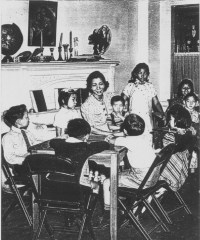 Did We Love Her Out Of Hell, Guys?“Atheist Leader Quits in Dallas,” the heading on this news item said:
Did We Love Her Out Of Hell, Guys?“Atheist Leader Quits in Dallas,” the heading on this news item said:DALLAS (UPI)—Madalyn Murray O’Hair has quit as the unofficial leader of American atheists. She said attacks by the Christian community and the lack of support of other atheists proved too much.
“I quit,” she said. “Anyone who desires to take over leadership of the American atheist community can have it.
“For thirteen years the Christian community in the U.S. has abused and brutalized me.”
Congratulations, guys. We did it. We took on that compact little Irishperson and beat her. We forced her into a corner and made her quit. We grabbed that woman who took our prayers out of the public schools … that woman who almost made the astronauts stop reading Genesis … that woman who tried to take our religious programs off the air … and we thrashed her good. Nice going, men.And we did it our way. Verbal abuse. Hate mail. Vitriolic prayers. Pressure. Pressure. Pressure.We did it.We divided the atheistic community and wiped their noses in the dirt. Once more, because of us, the forces of good triumphed over evil. The Father must be proud of us today. Jesus rejoices. The Holy Spirit’s happy. We did her in.And I’m sure she’s convinced now that Christ is really the answer. That love does make the world go round. That Christians do have it together and are faithful to their leader. After all, didn’t Jesus abuse and brutalize the people he overcame?Nice going, guys. The world’s a better place because of us.EUTYCHUS VII• Soon after that press conference Ms. O’Hair repudiated her statement. Eutychus says that proves all atheists are indecisive—ED.High MarksThe illustrations by Joe DeVelasco are super plus (Jan. 30 and Feb. 27 issues). Chicago TribuneWAYNE STAYSKALChicago, Ill.Roof ReliefIt was with real interest that I read your news story in the February 27 issue, “Tragedy in Guatemala,” and the March 12 story on relief activities after the tragic earthquake there. I know that in an operation of this kind it is very easy to overlook the work of some organizations. Seventh-day Adventist World Service was there. In addition to the nearly 0,000 worth of relief which we have already expended in Guatemala, we have now ordered another 0,000 worth of aluminum roofing which will be sent on eleven tractor trailers to San Francisco, where it will be loaded on ship. This is important, as the 1.5 million homeless people need to be placed under roofs; the rainy season is about to begin. Seventh-day Adventist World Service has set as a goal 5,000 houses which we will rebuild in this devastated country.We are happy to report that of 14,000 members we have in the country, only six were killed, and only 300 families were made homeless. We do, however, feel that our obligation is to everyone, which of course is the type of relief we give throughout the world.H.D. BURBANKExecutive SecretarySeventh-day Adventist World Service Inc.Washington, D. C.• In fast-breaking articles of this type it is often not possible to list every group that is involved. Our stories were intended to portray the types of relief being provided.—ED.Help That RefreshesThe more I read your magazine, the more refreshing help I derive from its articles. I am especially grateful for the article “Christianity Faces the Eighties” (Feb. 27). As much as we’d like to stick our haloed heads in the sands and wait till all the bad weather passes, it just isn’t practical.… The article on euthanasia in the same issue is one of which I hope to see many more.(Mrs.) CHARLOTTE RIEGELLumphanan, AberdeenshireScotlandThank you for publishing Gary Hardaway’s [article]. We Christian futurists rejoice at the appearance of such articles in your journal. Perhaps instead of developing a “last days” mentality, we should develop a “first days” mentality. From this perspective we can define a more forceful and creative ethic for the 1980s. Hardaway’s article would have been much stronger had he expanded the thoughts in the last eight lines of his second point. This is the heart of the matter.R. HOWARD MCCUEN, JR.Stone United Presbyterian ChurchWheeling, W. Va.The Rent Free MythIn your editorial “Where Do Retired Pastors Live?” (March 12) you made an excellent point, but at the expense of disseminating some false information. You referred to the “pastor’s rent-free housing,” and this just isn’t so. Instead of a minister earning X number of dollars he earns X minus ,000 (give or take 0) and he lives in the parsonage. He is, in effect, renting from the church. His situation differs from other renters because most churches do not adequately maintain their parsonages. The minister keeps it up; he improves their property while its value appreciates with the rising cost of real estate. Having renovated three parsonages with my own time and money, and having spent the first nineteen years of my ministry without a nickel of equity built up, I appreciate the sentiment of your article, but wish to demythologize the ancient superstition that the minister lives rent-free.W. NORMAN MACFARLANEPhilippus United Church of ChristCincinnati, OhioMarred InterviewYour welcome and timely interview with Charles Colson (March 12) was sadly marred by the egregious picture on the cover.… I know he became famous for saying that he’d walk over his grandmother if it would help Nixon get reelected, but that unfortunate statement belongs to his pre-conversion past which he has repudiated. Why rake it up again when he is trying hard to make a new life for himself?EDWARD A. JOHNSONOhiowa, Neb.Unique ThumbnailSincere, hearty thanks are due to you once again for providing a splendid thumbnail review of the latest Christian books (March 12). No one else does this sort of thing.ALAN J. RIDERHoly Cross Lutheran ChurchLivermore, Calif.Where ‘Obey’?My friend Harold Lindsell seems to have read something into the New Testament when he refers to the biblical injunction for wives to “obey” their husbands (Current Religious Thought, “Egalitarianism and Scriptural Infallibility,” March 26). Nowhere in the New Testament are wives commanded to “obey” their husbands or husbands encouraged to exercise authority over their wives. However, the New Testament requires all Christians to be subject to each other. This includes wives submitting to their husbands as well as husbands to their wives.GILBERT BILEZIKIANAssociate Professor of Biblical StudiesWheaton CollegeWheaton, IllHarold Lindsell’s article has prompted this support of egalitarian marriage and biblical infallibility. The two are not incompatible as he has implied. The crux of his argument seems to be that egalitarian marriage and wifely submission are mutually exclusive concepts, and since wifely submission has biblical support that therefore egalitarian marriage cannot. They need not be mutually exclusive concepts as long as wifely submission is not considered the whole picture. A marriage of mutual submission of wife to husband and husband to wife certainly qualifies as an egalitarian marriage. Moreover, it does not contradict Scripture. Since mutual submission is the pattern set up for all Christians, then surely this pattern must exist in the Christian marriage as well. Nowhere in the Bible is the husband commanded to “lord it over” his wife. That kind of language is reserved for the curse of sin as a result of the Fall. Egalitarian marriage is the pattern present in Genesis before the Fall, and there is no indication that the “new heaven and the new earth” will have anything to do with the order established by that curse. In the meantime, husbands are told by Paul to love their wives. Our understanding of what it means to love as we have learned through the whole messsage of the New Testament is intimately bound up in the idea of service and submission. If Paul’s language on the subject (submission for wives and love from husbands) in the Ephesians 5 passage seems to indicate different requirements for the different sexes it is only because we … are blinded by the order that sin has created—and have even gone so far as to absolutize that order and claim that God’s infallible Word promotes it.BETTY M. VANDERSCHAAFIowa City, IowaI would like to ask Dr. Lindsell how he interprets the following passages in terms of twentieth-century church practice: First Corinthians 11:2–16 (veiling of women, length of hair); First Corinthians 14:33–35 (women speaking in church); First Timothy 2:8–15 (women’s apparel, women not allowed to teach or have authority over men).… If he is going to call Drs. Jewett and Mollenkott, Ms. Hardesty and Ms. Scanzoni heretics, then let him come right out and say so. These are very serious accusations [he] is raising.JOHN D. KEPLERAssociate PastorNewport Covenant ChurchBellevue, Wash.To Think And ActLet me thank you for the outstanding issue of January 16. As I turned through the pages before reading, I found it hard to know where to begin.… “The Passivity of American Christians” is one of the finest pieces I have seen in a very long time. Indeed it does give us much to think upon and some things to act upon, which is always helpful. Just one little question about what I feel sure was an error: surely in the twelfth line down on the last column the word protest should have been protect! This would make a difference in the meaning, and it might not be as readily recognizable as wisdom in the final paragraph, which any reader would know should be wisdom.CLARA H. STUARTNew Orleans, La.• Thanks for the corrections—ED.ERRATUMIn the February 27 news story “The Rise and Fall of Billy James,” it was stated that the board of American Christian College agreed to give Mr. Hargis an annual stipend of ,000. Instead, the funds were to come from the David Livingstone Missionary Foundation
After purchasing the building, Mabel was still reluctant to stay. She had never pursued ministry. During a visit to China in 1929, she wrote wistfully, “It seems that China is run by my personal friends. One is head of this University and another of that; one is in charge of all the railroads in China, and another of Finance or Education.”At the time of his death, the Chinese mission had been renting its facilities. But Mabel wanted the organization to have its own building. She initiated a successful campaign to acquire a building in Chinatown in memory of her father after pooling together funds raised from the Chinatown community, a personal loan, and a loan from the denomination’s mission’s body. The mission, now the First Chinese Baptist Church of New York City, still stands in the heart of Chinatown today.
But hope for a temporary stay in New York faded as political conditions in China worsened. It also became evident that the survival of the mission during the Great Depression depended on Mabel’s skills. Most importantly, she could not suppress what she shared in common with her father: a passion for winning souls for Christ and a determination to engage the social problems of Chinatown.
In the 1930s, New York City’s Chinatown demographics were on the brink of change. At the beginning of the decade, the neighborhood had a 10:1 ratio of men to women. The population of children and families grew slowly, even after the repeal of the Chinese Exclusion Act in 1943. After World War II, however, war brides and refugees increased the Chinese American population dramatically and created an urgent need for spiritual and material care. Mabel’s educational background and bilingual skills were invaluable for bridging the gap between Chinese people and the wider English-speaking community during this time.
 The Gospel And ArchitectureThe purpose and duty of a church is to preach the full Gospel, purely and powerfully, and to minister to the needs of its people. But a congregation should also realize that the architecture of its building or buildings is a matter of Gospel.I don’t wish to imply that the responsibility of a church is to proclaim the virtues of fine building, or that salvation is dependent upon good architecture. Salvation is a free gift of God through faith in Christ. It seems to me, though, that when salvation comes, when our lives are transformed by a renewing of our minds after we have offered our bodies as a living sacrifice to God, as we work out the implications of our salvation, as we grow in the fear and knowledge of the Lord, then all aspects of our lives are subject to renewal: our work, our play, our social lives, even our architecture. This renewal is not a condition for our salvation; it is rather an expression of our thankfulness for it.Having said all this I want to repeat that the architecture of the Church is neither irrelevant nor unimportant; it is a matter of Gospel. The building that a church occupies and the furnishings within it either reinforce or contradict what the church preaches. I am sure that this is why God himself was the architect of the Tabernacle of the Israelites (Exodus 35 through 39). Architecture is not to be ignored or left only to the elite and artistically sensitive. All Christians should strive to live aesthetically as well as theologically obedient lives as part of their service to God.There are some signs that churches are increasing in awareness of the relation of church architecture to their message. New church buildings as often as not seat the congregation in circular, semi-circular, and opposing patterns rather than in the traditional parallel rows facing one end of the church. The latter is not unlike a theater where people gather to watch a performance on the stage. No interaction is encouraged between spectators.The circular, semi-circular, or opposing arrangements are conducive to interaction. They therefore express the truth that a church is a family of believers gathered out of the world to worship, have fellowship, and break the Bread of Life together. One congregation I recently visited had moved the pulpit to a side wall of the church and reorganized the seating in sections around it. When new church buildings are being designed, these new patterns of seating lead naturally to non-traditional building forms—circular, semi-circular, hexagonal—that suggest on the outside the nature of the Body of Christ on the inside.Evangelical churches recognize, theologically, the centrality of the Word and the sacraments. But far too often the pulpit, table, and font, the furniture associated with the Word and Sacraments, are found amidst the visual clutter of religious symbols, collection baskets, flags, flowers, piano, and organ, all competing for the attention of the congregation.Some churches, however, have expressed architecturally their belief in the centrality of the Word and sacraments, usually by placing the pulpit, table, and font in a visually balanced arrangement against an undistracting background. Flags and flowers and other accouterments of church life are located elsewhere. There are other possibilities, of course. One is to place the baptismal font near the entrance, a reminder that entrance to the Church is through the washing away of sin.The design of the furniture itself is important to the truth it expresses. A well-designed sounding board over the pulpit is a powerful visual statement of the importance of preaching the Word. One of the best communion tables I’ve seen was simply a table with place settings, surrounded with chairs. It reinforced architecturally the truth that communion is a celebration by the family of God of the Lord’s death and his victory over sin. There is a baptismal font that is fixed in my memory because it so appropriately symbolized the meaning of baptism. It was a granite basin four feet or more in diameter filled to the brim with clean, gently circulating water, shimmering in the light and always in full view of the worshiping congregation. The water-filled basin was a reminder that through Christ we are cleansed from our sins and that through the Holy Spirit our lives are daily washed and renewed. How much more fitting is this font than the more usual covered one pushed off to the side until the occasion arises for a baptism.Although in almost all evangelical churches music is an important part of worship, few have been able to integrate the instruments and choir into the building in a way that expresses their proper role in the service. Too often they are located with the pulpit, table, and font at the focal point of the sanctuary. This location gives the impression that music functions as entertainment or an intermission in the service, or worse, that it, along with the Word and Sacraments, is a means of grace. Actually music is part of the response of God’s people to his grace. Rightfully, then, the instruments and the choir, in order to augment the worship and to lead and reinforce the singing of the congregation, should be physically part of the congregation.It is the total building design, however, where the greatest contradictions occur. I am delighted to see the joy of Christianity expressed in the colorful banners that are displayed in some churches these days, but the banners cannot outshout what the building itself silently proclaims. We can’t believably contend that Christianity is for contemporary man from behind the false fronts of imitated historical styles. We can’t preach the genuineness of the Christian life from within buildings that display imitation stone, imitation stained glass, imitation wood, and imitation plants. Nor can we profess our concern for the plight of the world from interiors whose emphasis is on comfort or luxury. Our building must stand as a critique of the values of our age or the impact of what we preach will be diminished.I hesitate to be critical in an area where we as Christians are largely unacquainted. God does call us to be obedient, however, in all areas of life, so we have a responsibility to increase our knowledge and sensitivity. For help in doing this I suggest two books, Christ and Architecture by D.J. Bruggink and When Faith Takes Form by C. H. Droppers.RICHARD A. SMITSRichard A. Smits is a senior studio architect with Skidmore Owings and Merril, Chicago, Illinois.Seuss For Goslings—Seuss For GeeseChildren’s stories have provided me, as an adult, with hours of pleasure. They’ve helped me escape my daily responsibilities and pressures. Everyone needs vacations: I prefer the inexpensive ones that I can take each time I open a familiar book, or try out a new one. Especially when I finish a captivating children’s story I am better able to pick up my adult life.Books about children’s books can be just as refreshing and entertaining. Down the Rabbit Hole, by Selma G. Lanes, is a first-rate example. Atheneum has just issued it as a “college edition” paper-back; it was originally published in 1971.Selma Lanes does more than give us a history of children’s literature. (“The chapters that follow are frankly idiosyncratic,” she writes at the outset—rather like this column). She treats the genre seriously and argues for excellence. Children’s books are not easy to write—or necessarily easier to write than a tale for adults, contrary to what many people think. Lanes quotes Walter de la Mare: “I know well that only the rarest kind of best in anything can be good enough for the young.” Those wanting to write for children should always have that sentence before them.Lanes ranges through the realm of children’s stories with a sure hand and a smooth style. She understands the relationship children have with their books, and for those adults who lack this insight she lays the paths plain. Her chapter titles alone make the book worth its .95 price. “Seuss for the Goose Is Seuss for the Gander” is my favorite.In “Who Killed St. Nicholas?” Lanes explains the theory of writing for children by citing that first juvenile magazine, St. Nicholas. And whether she is considering books for blacks, or picture books, or illustrators her apt examples give body to her theories.Although Down the Rabbit Hole does not deal with religion specifically, it approaches children’s literature from a spiritual perspective. “In the best of children’s books, … we find this quality of spiritual refreshment, of things seen simply and savored truly as they might have been on the first day of creation” (p. 211). That brings us back to my initial comment: adults need that kind of spiritual refreshment just as much as children—perhaps even more.For me that usually comes from a fairy tale. Thomas Nelson’s new edition of Arthur Ransome’s Old Peter’s Russian Tales, first published in 1916, is a fine example. This handsome book features a new set of illustrations by Faith Jacques.In the first “Note” to the collection Ransome writes that “In Russia hardly anybody is too old for fairy stories.… I think there must be more fairy stories told in Russia than anywhere else in the world.” Certainly the love of taletelling shows in every paragraph. There is just enough of a continuum with Old Peter and his grandchildren to give the book unity without destroying its “short-storyness.” The tales are crisp and clear, like the snow and sharp air surrounding Old Peter’s hut. The simple acceptance of God’s providence found in these stories helps us understand what Jesus meant when he spoke to his disciples of “becoming childlike.” Ransome’s Russian tales were new to me; I highly recommend them.Fables and fairy tales are for the childlike of whatever age. Theologian and literary critic Mary McDermott Shideler has just published a slim volume of such fables, Mother and the Flying Saucer and Other Fables (Pegana Press, .95). The best tale is the first one, used in the title. I hope she’ll write more like it. The best feature of the book is the reprint of a story and essay from Theology Today, “Philosophies and Fairy-Tales.” Children won’t understand it, but adults will see why fairy tales are important to us all.“The ‘feeling intellect,’ ” McDermott says, “is a state we achieve only rarely.” We need that kind of wholeness. Each of these books for and about children and the childlike will help us approach a balanced life, a feeling intellect.CHERYL FORBES
The Gospel And ArchitectureThe purpose and duty of a church is to preach the full Gospel, purely and powerfully, and to minister to the needs of its people. But a congregation should also realize that the architecture of its building or buildings is a matter of Gospel.I don’t wish to imply that the responsibility of a church is to proclaim the virtues of fine building, or that salvation is dependent upon good architecture. Salvation is a free gift of God through faith in Christ. It seems to me, though, that when salvation comes, when our lives are transformed by a renewing of our minds after we have offered our bodies as a living sacrifice to God, as we work out the implications of our salvation, as we grow in the fear and knowledge of the Lord, then all aspects of our lives are subject to renewal: our work, our play, our social lives, even our architecture. This renewal is not a condition for our salvation; it is rather an expression of our thankfulness for it.Having said all this I want to repeat that the architecture of the Church is neither irrelevant nor unimportant; it is a matter of Gospel. The building that a church occupies and the furnishings within it either reinforce or contradict what the church preaches. I am sure that this is why God himself was the architect of the Tabernacle of the Israelites (Exodus 35 through 39). Architecture is not to be ignored or left only to the elite and artistically sensitive. All Christians should strive to live aesthetically as well as theologically obedient lives as part of their service to God.There are some signs that churches are increasing in awareness of the relation of church architecture to their message. New church buildings as often as not seat the congregation in circular, semi-circular, and opposing patterns rather than in the traditional parallel rows facing one end of the church. The latter is not unlike a theater where people gather to watch a performance on the stage. No interaction is encouraged between spectators.The circular, semi-circular, or opposing arrangements are conducive to interaction. They therefore express the truth that a church is a family of believers gathered out of the world to worship, have fellowship, and break the Bread of Life together. One congregation I recently visited had moved the pulpit to a side wall of the church and reorganized the seating in sections around it. When new church buildings are being designed, these new patterns of seating lead naturally to non-traditional building forms—circular, semi-circular, hexagonal—that suggest on the outside the nature of the Body of Christ on the inside.Evangelical churches recognize, theologically, the centrality of the Word and the sacraments. But far too often the pulpit, table, and font, the furniture associated with the Word and Sacraments, are found amidst the visual clutter of religious symbols, collection baskets, flags, flowers, piano, and organ, all competing for the attention of the congregation.Some churches, however, have expressed architecturally their belief in the centrality of the Word and sacraments, usually by placing the pulpit, table, and font in a visually balanced arrangement against an undistracting background. Flags and flowers and other accouterments of church life are located elsewhere. There are other possibilities, of course. One is to place the baptismal font near the entrance, a reminder that entrance to the Church is through the washing away of sin.The design of the furniture itself is important to the truth it expresses. A well-designed sounding board over the pulpit is a powerful visual statement of the importance of preaching the Word. One of the best communion tables I’ve seen was simply a table with place settings, surrounded with chairs. It reinforced architecturally the truth that communion is a celebration by the family of God of the Lord’s death and his victory over sin. There is a baptismal font that is fixed in my memory because it so appropriately symbolized the meaning of baptism. It was a granite basin four feet or more in diameter filled to the brim with clean, gently circulating water, shimmering in the light and always in full view of the worshiping congregation. The water-filled basin was a reminder that through Christ we are cleansed from our sins and that through the Holy Spirit our lives are daily washed and renewed. How much more fitting is this font than the more usual covered one pushed off to the side until the occasion arises for a baptism.Although in almost all evangelical churches music is an important part of worship, few have been able to integrate the instruments and choir into the building in a way that expresses their proper role in the service. Too often they are located with the pulpit, table, and font at the focal point of the sanctuary. This location gives the impression that music functions as entertainment or an intermission in the service, or worse, that it, along with the Word and Sacraments, is a means of grace. Actually music is part of the response of God’s people to his grace. Rightfully, then, the instruments and the choir, in order to augment the worship and to lead and reinforce the singing of the congregation, should be physically part of the congregation.It is the total building design, however, where the greatest contradictions occur. I am delighted to see the joy of Christianity expressed in the colorful banners that are displayed in some churches these days, but the banners cannot outshout what the building itself silently proclaims. We can’t believably contend that Christianity is for contemporary man from behind the false fronts of imitated historical styles. We can’t preach the genuineness of the Christian life from within buildings that display imitation stone, imitation stained glass, imitation wood, and imitation plants. Nor can we profess our concern for the plight of the world from interiors whose emphasis is on comfort or luxury. Our building must stand as a critique of the values of our age or the impact of what we preach will be diminished.I hesitate to be critical in an area where we as Christians are largely unacquainted. God does call us to be obedient, however, in all areas of life, so we have a responsibility to increase our knowledge and sensitivity. For help in doing this I suggest two books, Christ and Architecture by D.J. Bruggink and When Faith Takes Form by C. H. Droppers.RICHARD A. SMITSRichard A. Smits is a senior studio architect with Skidmore Owings and Merril, Chicago, Illinois.Seuss For Goslings—Seuss For GeeseChildren’s stories have provided me, as an adult, with hours of pleasure. They’ve helped me escape my daily responsibilities and pressures. Everyone needs vacations: I prefer the inexpensive ones that I can take each time I open a familiar book, or try out a new one. Especially when I finish a captivating children’s story I am better able to pick up my adult life.Books about children’s books can be just as refreshing and entertaining. Down the Rabbit Hole, by Selma G. Lanes, is a first-rate example. Atheneum has just issued it as a “college edition” paper-back; it was originally published in 1971.Selma Lanes does more than give us a history of children’s literature. (“The chapters that follow are frankly idiosyncratic,” she writes at the outset—rather like this column). She treats the genre seriously and argues for excellence. Children’s books are not easy to write—or necessarily easier to write than a tale for adults, contrary to what many people think. Lanes quotes Walter de la Mare: “I know well that only the rarest kind of best in anything can be good enough for the young.” Those wanting to write for children should always have that sentence before them.Lanes ranges through the realm of children’s stories with a sure hand and a smooth style. She understands the relationship children have with their books, and for those adults who lack this insight she lays the paths plain. Her chapter titles alone make the book worth its .95 price. “Seuss for the Goose Is Seuss for the Gander” is my favorite.In “Who Killed St. Nicholas?” Lanes explains the theory of writing for children by citing that first juvenile magazine, St. Nicholas. And whether she is considering books for blacks, or picture books, or illustrators her apt examples give body to her theories.Although Down the Rabbit Hole does not deal with religion specifically, it approaches children’s literature from a spiritual perspective. “In the best of children’s books, … we find this quality of spiritual refreshment, of things seen simply and savored truly as they might have been on the first day of creation” (p. 211). That brings us back to my initial comment: adults need that kind of spiritual refreshment just as much as children—perhaps even more.For me that usually comes from a fairy tale. Thomas Nelson’s new edition of Arthur Ransome’s Old Peter’s Russian Tales, first published in 1916, is a fine example. This handsome book features a new set of illustrations by Faith Jacques.In the first “Note” to the collection Ransome writes that “In Russia hardly anybody is too old for fairy stories.… I think there must be more fairy stories told in Russia than anywhere else in the world.” Certainly the love of taletelling shows in every paragraph. There is just enough of a continuum with Old Peter and his grandchildren to give the book unity without destroying its “short-storyness.” The tales are crisp and clear, like the snow and sharp air surrounding Old Peter’s hut. The simple acceptance of God’s providence found in these stories helps us understand what Jesus meant when he spoke to his disciples of “becoming childlike.” Ransome’s Russian tales were new to me; I highly recommend them.Fables and fairy tales are for the childlike of whatever age. Theologian and literary critic Mary McDermott Shideler has just published a slim volume of such fables, Mother and the Flying Saucer and Other Fables (Pegana Press, .95). The best tale is the first one, used in the title. I hope she’ll write more like it. The best feature of the book is the reprint of a story and essay from Theology Today, “Philosophies and Fairy-Tales.” Children won’t understand it, but adults will see why fairy tales are important to us all.“The ‘feeling intellect,’ ” McDermott says, “is a state we achieve only rarely.” We need that kind of wholeness. Each of these books for and about children and the childlike will help us approach a balanced life, a feeling intellect.CHERYL FORBESMabel never married, though she was courted while in college. Instead, she dedicated her entire life to the Chinatown community. Mabel preached and taught each Sunday. She mobilized Christians from white churches to share the gospel with and serve the people of Chinatown. She organized classes in English, typewriting, radio, carpentry, and other skills for working class Chinatown residents and later, for newly arrived immigrants and their children.
Most significantly, Mabel helped make the Chinese mission a self-supporting and independent congregation by growing its membership and raising support from the wider community. This was a timely achievement. Mainline Protestant mission boards stopped supporting ethnic-specific churches and missions by the mid-20th century, fueled by beliefs that the assimilation of immigrants and the integration of African Americans were the inevitable final steps toward a non-racial society. The proliferation of hundreds of independent-minded Chinese churches in America since Mabel’s death in 1966 and the persistence of ethnically and racially distinct churches and community organizations today have proven these beliefs as—at best—premature.
The Salvation of China
The doors of First Chinese Baptist Church, New York City are still open today. Its current pastor even has the surname Lee. The church has continued to focus on welcoming immigrants and unifying the neighborhood, seemingly echoing a vision Mabel laid out so many years ago. By the end of World War II, mainstream American perceptions of Chinese Americans had changed drastically from early 20th century perceptions. As allies in the struggle against Japan, the Chinese garnered greater respect from Americans. Chinatown’s rival factions declared a truce in order to unify around China’s war efforts. Many Chinese church leaders joined or led efforts to rehabilitate the image of Chinatowns across the country, often by promoting them as cross-cultural educational opportunities (or, alternately, exotic dining and tourist traps).
“Let us therefore not forget the significance of our work in the mission. It may seem very small, but the influence is very vast,” wrote Lee just before her work truly started in 1925. “Every little we put in counts. [Let us] rededicate ourselves to our tasks, that every boy who comes into the Mission will be made to know Christ. Christianity is the salvation of China, and the salvation of the whole world.”
Tim Tseng, PhD, is the pastor of English ministries at Canaan Taiwanese Christian Church in San Jose, California, and affiliate of Fuller Theological Seminary’s Asian American Center. He is the founder and former executive director of the Institute for the Study of Asian American Christianity. His blog is timtseng.net

